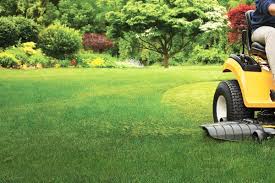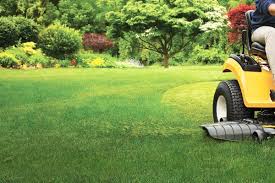Spring lawn care steps
Written by Joy
Sep 28 2020

Gardening experts pointed out that there are several important steps for lawn maintenance in spring, which are rooting, drilling and loosening the soil, sowing and liming. The earth rejuvenates and everything recovers. You should seize the opportunity to repair the lawn. Not only can you enjoy the beautiful scenery in summer and autumn, but also lay a solid foundation for extending the green period throughout the year, next year's growth and future maintenance. After that, paying attention to pruning and watering in time is the main step in spring lawn care steps.
The first step to let the lawn renew is to cut the grass roots. After a year of pressing, especially in the backyard lawn, some of the soil may be as tight as a mud cake, and air, nutrients and moisture are not easily penetrated. In addition, turfgrass has a well-developed root system, and the accumulation of one year has formed a dense root network, which is like the Internet on the garden surface, which greatly affects the permeability of the soil. Therefore, breaking the grass roots is the first step in spring lawn care steps.
April is the best time to cut grass roots. Special grass root cutters are divided into two types: steel blade cutters and plastic blade cutters. They can be driven into the soil to cut the grass roots and beat out the grass moss. The roots and old grass leaves are turned out of the ground and scattered in the soil, which are natural fertilizers for new grass. The loose soil after drilling is suitable for sowing grass seeds, and the grass seeds should be selected according to the different growth environment in the front yard and back of the house. If there is a lot of rain, after sowing, in a well-drained area, the seeds may be washed away by rain, so it is extremely important to cover a layer of fertilizer soil after sowing.
The loose soil after drilling is suitable for sowing grass seeds, and the grass seeds should be selected according to the different growth environment in the front yard and back of the house. If there is a lot of rain, after sowing, in a well-drained area, the seeds may be washed away by rain, so it is extremely important to cover a layer of fertilizer soil after sowing.
The sowing time should not be too late, otherwise it is easy to cause weed damage, and the lawns planted early are stronger and more resistant to trampling.
In spring fertilization, the appropriate ratio of nitrogen, phosphorus, and potassium is 8:2:4. Early fertilization is conducive to early greening of the lawn and paving the way for future growth, which can effectively improve the overall performance of the lawn throughout the growing season. If the soil fertility is too low, the lawn grows poorly, and the color is uneven, you need to re-fertilize between May and June to avoid malnutrition of the lawn.
Spring is the period when weeds begin to germinate and return to green and enter vigorous growth. A well-cultivated lawn has a certain inhibitory effect on weeds. However, some small weeds have strong vitality and rapid reproduction and maturity. Before the lawn turns green, there will be sprouts. If not treated, when the lawn grass turns green, there will still be weeds in the garden. Some weeds, such as dandelions, grow flat are crowding out and sheltering the lawn and other weeds. The root system is deeper than the lawn, and it competes with turf-grass for living space underground. Or gramineous weeds have a very strong reproductive ability and quickly invade the land area laterally; and the roots of some weeds can secrete chemicals to inhibit the growth of turf-grass.
These weeds will affect the normal growth of the lawn. If the treatment is not strengthened, there may be after-effects within a few years. Spring is the initiation period of these weeds and the best time for control. In addition to manual removal, chemical weeding is still a highly efficient method. For the weeds that appear before and after the turf-grass in early spring, you can apply granular herbicides and irrigate after application, such as once in May and June, to basically control the occurrence of weeds.
Grassroots
Generally, the type of lawn planted in the garden of a single house can be divided into front lawn, backyard and shady according to the area. The grass you can plant in the front yard is relatively small and tender. The grass species in the backyard The vitality of the type is more tenacious, and it looks stronger, so you don't have to worry about having children playing on it. On the wall or corner of the yard, it's best to choose shady grass, even in low sunlight.The first step to let the lawn renew is to cut the grass roots. After a year of pressing, especially in the backyard lawn, some of the soil may be as tight as a mud cake, and air, nutrients and moisture are not easily penetrated. In addition, turfgrass has a well-developed root system, and the accumulation of one year has formed a dense root network, which is like the Internet on the garden surface, which greatly affects the permeability of the soil. Therefore, breaking the grass roots is the first step in spring lawn care steps.
April is the best time to cut grass roots. Special grass root cutters are divided into two types: steel blade cutters and plastic blade cutters. They can be driven into the soil to cut the grass roots and beat out the grass moss. The roots and old grass leaves are turned out of the ground and scattered in the soil, which are natural fertilizers for new grass.
Loose soil
Drilling holes in the ground is a good way among spring lawn care steps. Several rows of gear-shaped punching machines pull out the too dense soil on the lawn, greatly reducing the density of the soil. Each hole is the thickness of the finger. In this way, the dense soil becomes soft and easy to penetrate by air, moisture and fertilizer. The loosening of the soil needs to be carried out before fertilization or replanting to lay a solid foundation for the next step of fertilization and reseeding.Reseeding
Sowing can be carried out after the ground has been drilled. It is best to cover with a layer of soil after sowing to prevent the wind from blowing the seeds away or birds pecking them. Therefore, sowing should also choose sunny weather. Rain and wind are both potential seeds in spring lawn care steps.
The sowing time should not be too late, otherwise it is easy to cause weed damage, and the lawns planted early are stronger and more resistant to trampling.
Fertilize
After a winter, the nutrients stored in the root system of turf-grass have been exhausted. After reseeding and before the turf-grass shows signs of growth, topdressing should be added to allow the turf to adjust its condition to meet the summer rain and sunshine, and quickly enter the vigorous growth period.In spring fertilization, the appropriate ratio of nitrogen, phosphorus, and potassium is 8:2:4. Early fertilization is conducive to early greening of the lawn and paving the way for future growth, which can effectively improve the overall performance of the lawn throughout the growing season. If the soil fertility is too low, the lawn grows poorly, and the color is uneven, you need to re-fertilize between May and June to avoid malnutrition of the lawn.
Adjust soil pH
One week after planting and fertilizing, you can lime the lawn to adjust the pH. Acidic soil is easy to grow moss and weeds, and lime powder can prevent weeds from growing.Spring is the period when weeds begin to germinate and return to green and enter vigorous growth. A well-cultivated lawn has a certain inhibitory effect on weeds. However, some small weeds have strong vitality and rapid reproduction and maturity. Before the lawn turns green, there will be sprouts. If not treated, when the lawn grass turns green, there will still be weeds in the garden. Some weeds, such as dandelions, grow flat are crowding out and sheltering the lawn and other weeds. The root system is deeper than the lawn, and it competes with turf-grass for living space underground. Or gramineous weeds have a very strong reproductive ability and quickly invade the land area laterally; and the roots of some weeds can secrete chemicals to inhibit the growth of turf-grass.
These weeds will affect the normal growth of the lawn. If the treatment is not strengthened, there may be after-effects within a few years. Spring is the initiation period of these weeds and the best time for control. In addition to manual removal, chemical weeding is still a highly efficient method. For the weeds that appear before and after the turf-grass in early spring, you can apply granular herbicides and irrigate after application, such as once in May and June, to basically control the occurrence of weeds.
Prune
Experts recommend that everyone cut the grass one month after planting. Around the end of May, the lawn has all turned green and the top growth is too strong and the leaf splitting appears. There are two types of lawn mowers: rollers and lateral lawn mowers. Rolling lawn mowers are suitable for lawns that are not growing very high. Too high grass is easy to be caught in the roller, but it cannot be cut low. A lateral lawn mower is suitable. For mowing higher lawns, before each mowing, the rocks and other debris on the lawn must be removed. When mowing, the trimmer should be adjusted to a suitable height according to different types of lawns before wheel Edger. You’d better not wait until the grass grows too high before mowing. The lawn will suffer too much damage, the wound will not recover easily, and it will be easy to get disease.Irrigation
If there is plenty of rain, the soil generally does not lack water, but if there is little rain for days, it is very necessary to water it in time. When the surface soil is dry, and after fertilization or pesticide application in spring, supplement watering should be started immediately. The water is best to penetrate deep into the soil. For areas with poor drainage, special attention should be paid to dredging the drainage to avoid the occurrence and spread of diseases. Flat terrain must also be irrigated when the soil moisture cannot meet the growth needs of the lawn, otherwise it will easily cause water siltation and cause pests.Latest Updated
- Benefits of Bugleweed - 7 Science-backed Health Benefits
- Bugleweed Dangers & Side Effects - Is It Poisonous?
- How to Plant Evergreen Trees - What You Should Know
- When to Plant Evergreens - Grow Guide for Evergreen Trees
- 12 Wonderful Evergreen Shrubs for Your Garden
- 12 Popular Evergreen Plants with Pictures for Beginners
- When And How To Prune A Lilac Bush Like a Pro
- How to Grow & Care for Lilac Vine (Hardenbergia Violacea)
- Japanese Lilac Tree (Syringa Reticulata) Care & Propagation Guide
- Shumard Oak Pros and Cons - What to Know
Popular Articles
- Winter maintenance of Antirrhinum Majus
- How to Grow Terminalia Mantaly Tree
- How to Grow and Care for Crossostephium Chinense
- How to grow Antirrhinum Majus in spring
- Peristeria Elata (Dove Orchid) Profile: Info & Care Guide
- Underwatered Snake Plant (Sansevieria Trifasciata) - Signs And How To Fix
- How to Care for Brazilian Jasmine Plant (Mandevilla Sanderi)
- How to Grow & Care for Graptopetalum Purple Delight in Summer
- Rosa Chinensis (China Rose): Plant Growing & Care Tips
- How to Care for Baby Sun Rose (Aptenia Cordifolia)